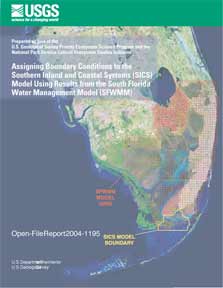
|
publications > ofr > assigning boundary conditions to the Southern Inland and Coastal Systems (SICS) Model using results from the South Florida Water Management Model (SFWMM)
Assigning Boundary Conditions to the Southern Inland and Coastal Systems (SICS) Model Using Results from the South Florida Water Management Model (SFWMM)
Wolfert, Melinda A., Langevin, Christian D., and Swain, Eric D.
U.S.G.S. Open File Report 2004-1195
Abstract
 |
| Figure 1. Location of the South Florida Water Management Model (SFWMM) grid and the outline of the Souther Inland Coastal Systems (SICS) model boundary. [larger image] |
|
The Comprehensive Everglades Restoration Plan (CERP) requires the testing and evaluation of different water-management scenarios for southern Florida. As part of CERP, the South Florida Water Management District is using its regional hydrologic model, the South Florida Water Management Model (SFWMM), to evaluate different hydrologic scenarios. The SFWMM was designed specifically for the inland freshwater areas in southern Florida, and extends only slightly into Florida Bay. Thus, the U.S. Geological Survey developed the Southern Inland and Coastal Systems (SICS) model, which is an integrated surface-water and ground-water model designed to simulate flows, stages, and salinities in the southern Everglades and Florida Bay. Modifications to the SICS boundary conditions allow the local-scale SICS model to be linked to the regional-scale SFWMM. The linked model will be used to quantify the effects of restoration alternatives on flows, stages, and salinities in the SICS area. This report describes the procedure for linking the SICS model with the SFWMM. The linkage is shown to work by comparing the results of a linked 5-year simulation with the results from a simulation in which the model boundaries are assigned using field data.
The surface-water module of the SICS model is driven by areal influences and lateral boundaries. The areal influences (wind, rainfall, and evapotranspiration) remain the same when the SICS model is modified to link to the SFWMM. Four types of lateral boundaries (discharge, water level, no flow, and salinity) are used in the SICS model. Two of three discharge boundaries (at Taylor Slough Bridge and C-111 Canal) in the current SICS model domain are converted to water-level boundaries to increase accuracy. The only change to the third discharge boundary (at Levee 31W) is that the flow data are derived from SFWMM model output instead of using measured field data flows. Three water-level boundaries are modified only by receiving their data from SFWMM model output data. Additionally, two marine water-level boundaries remain the same because the SFWMM does not include Florida Bay and, therefore, this model cannot provide input data for these boundaries. The SICS no-flow boundaries remain intact because no additional data, provided by the SFWMM, suggest that any significant flow occurs along these boundaries. The Florida Bay salinity boundary is not modified because the SFWMM does not contain any salinity data that can be used to modify the model.
The ground-water module of the SICS model contains a general-head boundary and a no-flow boundary. The general-head boundary, which extends along the edges of the wetland part of the SICS model domain, is modified by acquiring stage values from SFWMM cells that correspond in location to the SICS model cells. Values from the SFWMM cells are bilinearly interpolated and assigned to the appropriate SICS general-head boundary cells in all layers of the ground-water model. The ground-water no-flow boundary in Florida Bay is unaltered because the SFWMM does not include this area.
A 5-year simulation was developed to test the linkage of the SICS model with the SFWMM. Results from the linked model are similar to those obtained from the original SICS model in which boundaries are assigned using field data. The simulated discharges at the coastal creeks along Florida Bay are about 5 percent lower than the field data simulation; water levels in the wetlands are about 4 percent lower, and salinities at the various coastal creeks are slightly higher.
TABLE OF CONTENTS:
(The entire report is available for download below.)
- Abstract
- Introduction
- Purpose and Scope
- Acknowledgments
- Overview of Models
- South Florida Water Management Model
- Southern Inland and Coastal Systems Model
- Boundary Conditions Assigned Using Field Data
- Surface-Water Boundaries
- Ground-Water Boundaries
- Linked Model Boundary Conditions
- Surface-Water Boundaries
- Ground-Water Boundaries
- Model Comparison
- Summary
- References Cited
- Appendix I: Temporal Data-Collection Stations Used in the Southern Inland and Coastal Systems Model
- Appendix II: Sources Used to Develop Model Spatial Information
|


